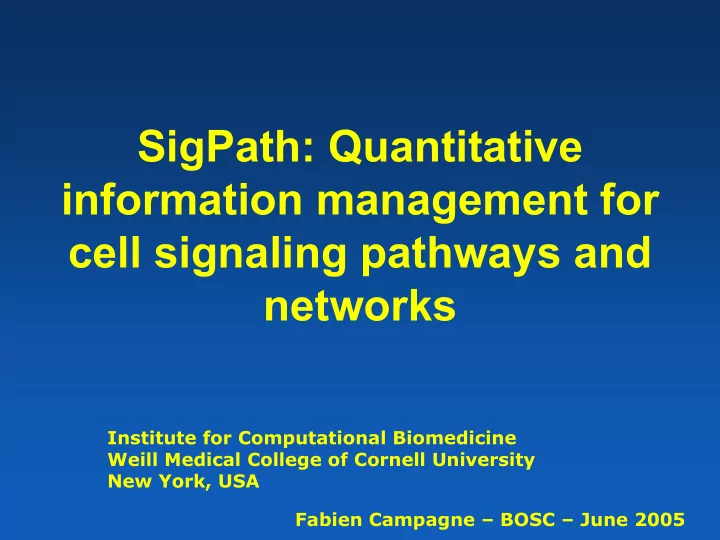

SigPath: Quantitative information management for cell signaling pathways and networks Institute for Computational Biomedicine Weill Medical College of Cornell University New York, USA Fabien Campagne – BOSC – June 2005
The SigPath Team & Sponsors NIH-NHLBI (Pre-NPEBC P20 program) NIH-NIDA (Signaling suppl. to P01 DA12923) Harel Weinstein NIH-NCI (R01 CA-81050) NIH-NIGMS (R01 GM 54-508) Ravi Iyengar Frueauff Foundation Fabien Campagne
Modeling integrated biochemical systems One Activated MAPK Various saturated measured concentrations concentration Bhalla US, Ram PT, Iyengar R. MAP kinase phosphatase as a locus of flexibility in a mitogen- activated protein kinase signaling network. Science. 2002 Aug 9;297(5583):1018-23. Entry in the Synthesis of History-dependent responses of the MAPK system cell-cycle arachidonic acid & Autocrine paracrine systems
Project goals • Provide means to collaboratively organize biochemical information electronically (w/ links to the primary literature) • Smoothly integrate with biochemical simulation tools. • Smoothly integrate with sequence and other bioinformatics databases • Provide a repository of facts/interpretations /hypotheses for interactions and models • User-friendly web-based system • Act as an educational resource • Going beyond (standard) file formats • Testing and developing new approaches to help manage biological information
h t t p : / / w w w . s i g p a t h . o r g
SigPath complements biochemical modeling environments
Comparison to other types of data and databases Data generally Graph-like Graph-like organized as data, many data, one or entries with few types of biochemical two connections entities, many types of types of between connections (e.g., biochemical entries. (Comparative through interactions, entities genomics changes the reactions, pathways) picture a bit..)
The SigPath ontology is derived from the EcoCyc ontology (Karp P), but includes many extensions. For instance, to represent quantitative features (e.g., rates, concentrations) and context of the measurements. Just a glimpse.. >80 classes in the current ontology
Data integration approach used for SigPath The ontology is implemented in the semantic validation layer and the Java Data Object-compliant database backend. (For JDO, see Srdanovic M et al. Critical evaluation of the JDO API for the persistence and portability requirements of complex biological databases. BMC Bioinformatics. 2005 Jan 10;6(1):5.) The approach is • Scalable (amount of data, # concurrent users) • Leverages open standards (e.g., XML, JDO) • Supports customized web-based user interfaces, web services, and batch processes
SigPath XML exchange format
SigPath provides tools for user communities These users are not curators, they are end- users who submit and edit information in SigPath. We designed SigPath to be a tool to manage data about work in progress. This requirement and the type of data managed raise interesting information management questions: • Is the submitter ownership policy the best option to encourage data sharing and data reuse? • How to best support different communities of users at different times
SigPath provides tools for user communities Registered users can track data they submitted spXXXX values are SigPath identifiers (spids for short). spids behave like accession codes and can be cited in articles.
Web-based Visualization (reaction) Reaction mechanism and kinetics Links to the literature User comments Change tracking
General Information Web-based Visualization Substrate/ (molecule) Product Links Reactions this molecule is involved in Concentrations measured for this molecule
General Information Reactions (details omitted) Initial Web-based Concentrations Visualization Exporting to (model) Modeling Environments Model Schematic (automatically generated)
Visualizing interactions is key for the end-user, but is still an open problem.. Data reproduced with permission from:
Visualizing interactions is key for the end-user, but is still an open problem..
SigPath Navigator • Helps users navigate data relationships and create custom views of the data, interactively • Desktop tool, connects to several SigPath instances • Cross-platform, Java WebStart (auto install&updates)
SigPath Navigator • Submit pathways interactively • Inspect connectivity of entries before deleting or editing data • Select SigPath entries and transfer to another SigPath instance
SigPath and Open Source • SigPath is distributed under the GPL • Leverages the JDO API, an open standard for database portability (object/relational databases, commercial and open-source) • An open-source JDO implementation (See ISMB Poster C-37) is on the way (see www.JPOX.org) • Towards a bio-database framework (reusing the SigPath code base for bio- database projects with similar requirements). • Interested in the project? Contact us!
Acknowledgment s NCBS: ICB: Pharmacology, Upi Bhalla MSSM Harel Weinstein VCell: Jim Schaff Eliza Chan Ravi Iyengar Manuel Martin Susana Neves SBML: Marko Srdanovik Violet Chang Mike Hucka, Piali Mukherjee Andrew Finney Check out our other open-source bioinformatics projects: TissueInfo – High-throughput tissue expression profiling with ESTs Textractor – Direct protein name dictionary construction from full-text ( Poster B-11 ) http://icb.med.cornell.edu
A few of the tools that help us build SigPath Open-source Free for open-source projects
Slides after this are for questions.
Related work At least three systems share goals similar to SigPath’s – ProcessDB Robert Phair and Ann Chason (commercial, free for academia http://www.integrativebioinformatics.com/processdb.html) (Focus is on modeling capabilities, rough UI) – Monod David Soergel, Brian George, Ross Morgan-Linial, Roger Brent, and Drew Endy (open-source http://monod.molsci.org/docs/Monod-June-2003.pdf ) (No quantitative data) – BioModels.net Le Novère et al. http://www.ebi.ac.uk/biomodels/ (April 2005) (open / closed source?) These systems differ in their approaches and capabilities
Recommend
More recommend